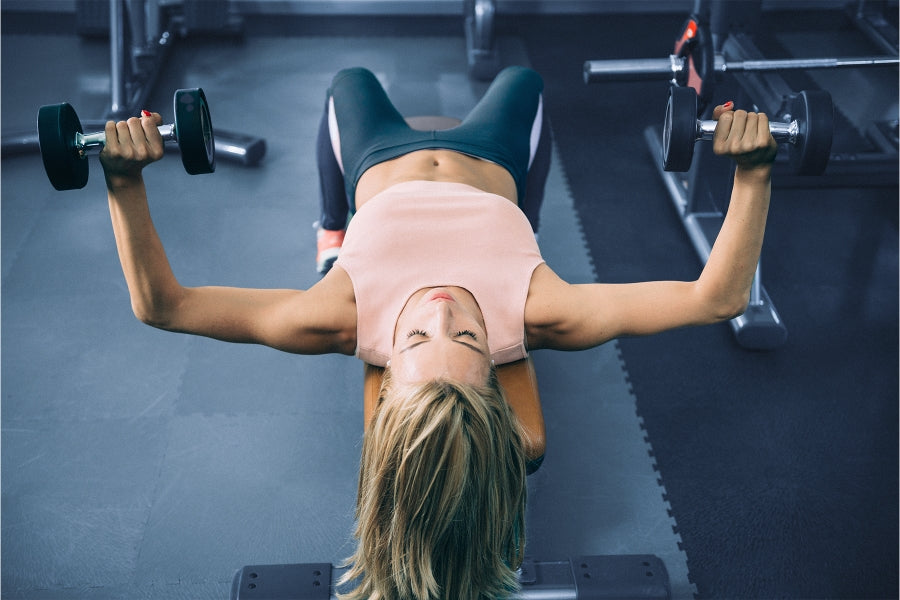The dumbbell bench press is a staple exercise for developing upper body strength, focusing primarily on the chest, shoulders, and triceps. Compared to the barbell version, dumbbells offer a greater range of motion and require increased stabilization, making them ideal for balanced muscle development and injury prevention.
To maximize strength gains and target different parts of the chest, incorporating variations of the dumbbell bench press is essential. This article explores the top three variations—flat, incline, and decline dumbbell bench presses—detailing their benefits and how to perform them correctly for optimal results.
1. Flat Dumbbell Bench Press
The flat dumbbell bench press is the foundational version, focusing on overall chest development with significant involvement from the anterior deltoids and triceps.
Benefits:
- Engages the pectoralis major fully with a natural range of motion.
- Increases muscle coordination due to independent arm movement.
- Improves joint stability by engaging smaller stabilizer muscles around the shoulder.
How to perform:
- Lie on a flat bench with a dumbbell in each hand, held above your chest.
- Keep feet flat on the floor and maintain a neutral spine with slight natural arch in the lower back.
- Lower the dumbbells slowly to chest level, elbows at about 45 degrees to your torso.
- Press the dumbbells back up until arms are nearly fully extended but avoid locking elbows.
- Focus on controlled, steady movements to maintain tension on the muscles.
The flat variation builds overall pressing strength and forms the base for the other variations.
2. Incline Dumbbell Bench Press
The incline dumbbell bench press shifts emphasis toward the upper chest and front shoulders by adjusting the bench angle between 30 and 45 degrees.
Benefits:
- Targets the clavicular head of the pectoralis major for fuller chest development.
- Strengthens the anterior deltoids more than the flat press.
- Enhances shoulder stability and functional strength due to increased range of motion and stabilization requirements.
How to perform:
- Adjust the bench to an incline angle between 30 and 45 degrees.
- Lie back with dumbbells held above your upper chest.
- Keep feet grounded and core engaged to maintain stability.
- Lower the dumbbells slowly toward the upper chest, maintaining elbows at about 45 degrees.
- Press the dumbbells back up with control until arms are extended but not locked out.
Incline presses are essential for balanced chest development and help prevent the common imbalance of an underdeveloped upper chest.
3. Decline Dumbbell Bench Press
The decline dumbbell bench press places the bench at a downward angle, typically between 15 and 30 degrees, focusing on the lower chest region.
Benefits:
- Emphasizes the sternal head of the pectoralis major, creating a fuller lower chest.
- Reduces stress on the shoulder joints, making it suitable for individuals with shoulder discomfort.
- Enhances pressing power and muscle balance by complementing flat and incline presses.
How to perform:
- Set the bench at a decline angle of 15 to 30 degrees.
- Position yourself securely on the bench with feet anchored to maintain stability.
- Hold dumbbells above the lower chest with arms extended.
- Lower the weights slowly toward the lower chest while keeping elbows angled approximately 45 degrees.
- Press the dumbbells back up to the starting position with controlled movement.
The decline press is an excellent variation to diversify your chest training and address all areas for balanced growth.
Tips for Maximizing Dumbbell Bench Press Results
- Use appropriate weights that allow full control and maintain proper form throughout each variation.
- Focus on a controlled tempo, especially during the lowering (eccentric) phase, to maximize muscle tension.
- Keep elbows at roughly a 45-degree angle from your torso to protect the shoulders and enhance muscle activation.
- Engage your core and maintain a stable base with feet firmly on the ground or bench attachments.
- Incorporate progressive overload by gradually increasing weights or volume as your strength improves.
- Allow adequate rest between sets, typically 60 to 90 seconds for hypertrophy or longer for maximal strength training.
Integrating Variations Into Your Training
A well-rounded chest workout includes all three dumbbell bench press variations to ensure balanced development across the entire pectoral muscle group. For example, performing 3 sets of each variation with 8 to 12 reps can effectively promote muscle growth and strength gains.
You can also rotate variations weekly or incorporate them into supersets for increased training intensity. Combining dumbbell presses with complementary exercises such as push-ups, dips, or cable flyes further enhances chest strength and definition.
Final Thoughts
Mastering the flat, incline, and decline dumbbell bench press variations unlocks your potential for comprehensive upper body strength. Each variation targets unique portions of the chest and shoulder muscles while engaging stabilizers that improve functional fitness and reduce injury risk.
Consistency, proper form, and progressive overload are keys to maximizing the benefits of these exercises. Incorporate these variations into your training routine to build a stronger, more balanced chest and upper body.










